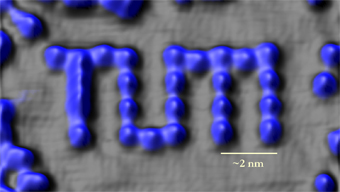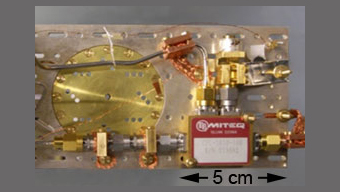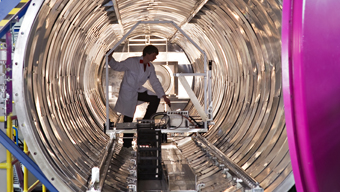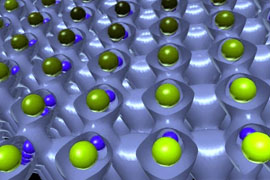Methoden und Instrumente
 Erzeugt durch Atommanipulation: Das TUM-Logo mit einer Breite von 8 nm, geschrieben mit 26 CO-Molekülen auf einer Kupferoberfläche
in (111)-Orientierung. Bild: TUM.PH/Barth Lab.
Seit den Anfängen der Experimentalphysik sind es neue Methoden und Instrumente, die neue Erkenntnisse liefern und uns erlauben theoretische Vorhersagen
zu überprüfen. In der Festkörperphysik werden Strukturen und Eigenschaften mit Hilfe von Streumethoden und Mikroskopie bestimmt und so spezielle
Fragestellungen aus verschiedensten Bereichen wie Magnetismus, Supraleitung, weicher Materie, korrelierte Elektronensysteme, Quantensysteme, Halbleiterphysik
oder Nanostrukturphysik beantwortet. Neuartige Messmethoden und Instrumentierung sowie spezielle Kristallzüchtungs- und Epitaxieanlagen sind also immer
ein Aufbruch zu neuen Ufern der Erkenntnis und haben entsprechend einen sehr hohen Stellenwert in der experimentellen Festkörperphysik. Entsprechend der
Vielfalt der Fragestellungen, die von der Festkörperphysik an der TU München bearbeitet werden, beherbergt das Physikdepartment einen eindrucksvoll
grossen und modernen Park an Instrumenten und Methoden auf allerhöchstem Niveau. Darüber hinaus finden methodische Weiterentwicklungen in allen
Bereichen mit einem hohen Stellenwert statt.
Erzeugt durch Atommanipulation: Das TUM-Logo mit einer Breite von 8 nm, geschrieben mit 26 CO-Molekülen auf einer Kupferoberfläche
in (111)-Orientierung. Bild: TUM.PH/Barth Lab.
Seit den Anfängen der Experimentalphysik sind es neue Methoden und Instrumente, die neue Erkenntnisse liefern und uns erlauben theoretische Vorhersagen
zu überprüfen. In der Festkörperphysik werden Strukturen und Eigenschaften mit Hilfe von Streumethoden und Mikroskopie bestimmt und so spezielle
Fragestellungen aus verschiedensten Bereichen wie Magnetismus, Supraleitung, weicher Materie, korrelierte Elektronensysteme, Quantensysteme, Halbleiterphysik
oder Nanostrukturphysik beantwortet. Neuartige Messmethoden und Instrumentierung sowie spezielle Kristallzüchtungs- und Epitaxieanlagen sind also immer
ein Aufbruch zu neuen Ufern der Erkenntnis und haben entsprechend einen sehr hohen Stellenwert in der experimentellen Festkörperphysik. Entsprechend der
Vielfalt der Fragestellungen, die von der Festkörperphysik an der TU München bearbeitet werden, beherbergt das Physikdepartment einen eindrucksvoll
grossen und modernen Park an Instrumenten und Methoden auf allerhöchstem Niveau. Darüber hinaus finden methodische Weiterentwicklungen in allen
Bereichen mit einem hohen Stellenwert statt.
 Ultratieftemperatur-Messsystem zur Analyse von extrem schwachen Mikrowellensignalen bei ultratiefen Temperaturen.
In den Arbeitsgruppen werden hochspezialisierte Laborexperimente durchgeführt, um die aktuellen Fragen des jeweiligen Forschungsgebiets zu untersuchen.
So werden zum Beispiel ultraschnelle Phänomene und Fragen der Quantenoptik mit Lasersystemen zur Erzeugung ultrakurzer Lichtimpulse in weit durchstimmbaren
Spektralbereichen bearbeitet. Durch die Manipulation einzelner Atome sowie die Steuerung raumzeitlicher Selbstorganisation werden grundlegende Fragen der
Oberflächenphysik adressiert. Hochauflösende Rastersondenmikroskopietechniken zielen auf das fundamentale Verständnis von Phänomenen an Grenzflächen sowie
deren Kontrolle zum Design funktioneller, niedrig-dimensionaler Nanostrukturen ab. Messapparaturen zur Erzeugung ultratiefer Temperaturen, starker
Magnetfelder und hoher Drücke erlauben das Studium von Festkörpereigenschaften unter extremen Bedingungen. Mit spektroskopischen Methoden können sowohl
Transportphänomene in Halbleiternanostrukturen als auch niedrigdimensionale Quantensysteme untersucht werden. Modernste Mikrowellen-Messtechnik erlaubt es,
kollektive Spin-Anregungen auf der Nanometer-Skala zu detektieren sowie die Wechselwirkung von supraleitenden Quantenschaltkreisen mit einzelnen
Photonen zu untersuchen.
Ultratieftemperatur-Messsystem zur Analyse von extrem schwachen Mikrowellensignalen bei ultratiefen Temperaturen.
In den Arbeitsgruppen werden hochspezialisierte Laborexperimente durchgeführt, um die aktuellen Fragen des jeweiligen Forschungsgebiets zu untersuchen.
So werden zum Beispiel ultraschnelle Phänomene und Fragen der Quantenoptik mit Lasersystemen zur Erzeugung ultrakurzer Lichtimpulse in weit durchstimmbaren
Spektralbereichen bearbeitet. Durch die Manipulation einzelner Atome sowie die Steuerung raumzeitlicher Selbstorganisation werden grundlegende Fragen der
Oberflächenphysik adressiert. Hochauflösende Rastersondenmikroskopietechniken zielen auf das fundamentale Verständnis von Phänomenen an Grenzflächen sowie
deren Kontrolle zum Design funktioneller, niedrig-dimensionaler Nanostrukturen ab. Messapparaturen zur Erzeugung ultratiefer Temperaturen, starker
Magnetfelder und hoher Drücke erlauben das Studium von Festkörpereigenschaften unter extremen Bedingungen. Mit spektroskopischen Methoden können sowohl
Transportphänomene in Halbleiternanostrukturen als auch niedrigdimensionale Quantensysteme untersucht werden. Modernste Mikrowellen-Messtechnik erlaubt es,
kollektive Spin-Anregungen auf der Nanometer-Skala zu detektieren sowie die Wechselwirkung von supraleitenden Quantenschaltkreisen mit einzelnen
Photonen zu untersuchen.
 Die Untersuchung von kleinen Strukturen braucht grosse Instrumente: Blick in Flugrichtung der Neutronen zum Detektor in eine
Kleinwinkelinstrument am FRM II.
Besonders hervorzuheben ist die Münchner Forschungs-Neutronenquelle Heinz Maier-Leibnitz (FRM II), die eine einmalige Palette an Instrumentierung rund um
die Nutzung von Neutronen zur Verfügung stellt. Diese teilweise einzigartige Infrastruktur umfasst viele verschiedene Streumethoden wie zum Beispiel
Neutronendiffraktion, Neutronenklein- und Ultrakleinwinkelstreuung, Streuung unter streifendem Einfall und Reflektometrie, inelastische Streuung mit
höchster Auflösung und die Streuung polarisierter Neutronen. Komplementär zu diesen Streumethoden sind hochauflösende Tomographie oder zeitaufgelöste
Radiographie mit Neutronen verfügbar. Entsprechend gibt es hervorragende Möglichkeiten für Strukturbestimmungen von atomaren oder molekularen Strukturen
bis hin zu makroskopischen Längenskalen, Vermessung von dynamischen Prozessen im Bereich von Zeitskalen reichend von Picosekunden bis mehreren 100
Nanosekunden und zur Untersuchung von magnetischen Prozessen auf einer atomaren und molekularen Längenskala. Zudem beherbergt der FRM II die
weltweit brillanteste Positronenquelle. Mit Positronen induzierter Augerspektroskopie sind zum Beispiel die elektronischen Strukturen der obersten
atomaren Schicht eines Festkörpers messbar.
Die Untersuchung von kleinen Strukturen braucht grosse Instrumente: Blick in Flugrichtung der Neutronen zum Detektor in eine
Kleinwinkelinstrument am FRM II.
Besonders hervorzuheben ist die Münchner Forschungs-Neutronenquelle Heinz Maier-Leibnitz (FRM II), die eine einmalige Palette an Instrumentierung rund um
die Nutzung von Neutronen zur Verfügung stellt. Diese teilweise einzigartige Infrastruktur umfasst viele verschiedene Streumethoden wie zum Beispiel
Neutronendiffraktion, Neutronenklein- und Ultrakleinwinkelstreuung, Streuung unter streifendem Einfall und Reflektometrie, inelastische Streuung mit
höchster Auflösung und die Streuung polarisierter Neutronen. Komplementär zu diesen Streumethoden sind hochauflösende Tomographie oder zeitaufgelöste
Radiographie mit Neutronen verfügbar. Entsprechend gibt es hervorragende Möglichkeiten für Strukturbestimmungen von atomaren oder molekularen Strukturen
bis hin zu makroskopischen Längenskalen, Vermessung von dynamischen Prozessen im Bereich von Zeitskalen reichend von Picosekunden bis mehreren 100
Nanosekunden und zur Untersuchung von magnetischen Prozessen auf einer atomaren und molekularen Längenskala. Zudem beherbergt der FRM II die
weltweit brillanteste Positronenquelle. Mit Positronen induzierter Augerspektroskopie sind zum Beispiel die elektronischen Strukturen der obersten
atomaren Schicht eines Festkörpers messbar.
 Theoretisch berechnete atomare Konfiguration und elektronische Struktur eines zweidimensionalen Nanogitters.
Die den physikalischen Eigenschaften kondensierter Materie zugrunde liegenden Prozesse laufen im atomaren und molekularen Bereich ab, also auf Nanometerskalen.
Trotz mächtiger experimenteller Methoden lassen sich physikalische Phänomene auf diesen Längenskalen ohne theoretische Modellierung kaum verstehen, erst recht
nicht vorhersagen und damit auch nicht umfassend beherrschen. Die Theoriegruppen in der kondensierten Materie am Physik Department entwickeln unter
Zugrundelegung der Quantenmechanik von Vielteilchensystemen leistungsfähige theoretische Methoden um ein mikroskopisches Verständnis und weitreichende
Vorhersagen für die Eigenschaften moderner Nanostrukturen zu ermöglichen sowie die Grundlagen komplizierte Festkörperphänomene zu erfassen.
Theoretisch berechnete atomare Konfiguration und elektronische Struktur eines zweidimensionalen Nanogitters.
Die den physikalischen Eigenschaften kondensierter Materie zugrunde liegenden Prozesse laufen im atomaren und molekularen Bereich ab, also auf Nanometerskalen.
Trotz mächtiger experimenteller Methoden lassen sich physikalische Phänomene auf diesen Längenskalen ohne theoretische Modellierung kaum verstehen, erst recht
nicht vorhersagen und damit auch nicht umfassend beherrschen. Die Theoriegruppen in der kondensierten Materie am Physik Department entwickeln unter
Zugrundelegung der Quantenmechanik von Vielteilchensystemen leistungsfähige theoretische Methoden um ein mikroskopisches Verständnis und weitreichende
Vorhersagen für die Eigenschaften moderner Nanostrukturen zu ermöglichen sowie die Grundlagen komplizierte Festkörperphänomene zu erfassen.